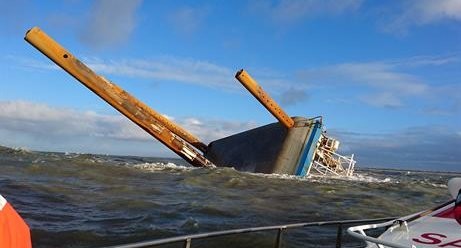
Operational Management of Change
Risk Management is essentially the removal of uncertainty and management of change is the exact same thing. Uncertainty is usually highest when people are taken out of their comfort zone, faced with rare or new operations).
(Data taken from the DMAIB Report): http://www.dmaib.com/Ulykkesrapporter/Final%20report%20-%20AMBER%20II%20and%20SEA%20WORKER.pdf
The Maltese tug AMBER II departed Frederikshavn on 24 January 2016 with its tow, the Danish manned installation jack-up platform SEA WORKER. The towage was bound for Esbjerg with an estimated time of arrival 26 January in the morning. The towing line between AMBER II and SEA WORKER broke on 27 January 2016, two and a half days after departure, while the towage was located in the North Sea, 6 nm off the west coast of Jutland and was facing difficulties making speed due to wind, waves and current. When the towing connection was lost, the tug did not succeed in reconnecting by means of the emergency towing equipment. As the platform was drifting uncontrollably towards shore, it was evacuated, because it was deemed dangerous for the crew to stay on board during the grounding.
The DMAIB Report notes, among others, that most marine operations in the organisation were conducted "In Project", with operational criteria stated by the charterer. "Out of Project" operations were rare. Not something crew and back office staff were used to.
Under these circumstances it would have been reasonable to treat the upcoming project as a Management of Change situation to adequate planning and controlled. Not necessarily because a new (mode of) operation was introduced but because operational criteria setting, planning and execution were now to be undertaken by the company instead of being provided by the charterer.
The report identifies a number of issues related to planning and control that a Risk Based (operational level) Management of Change process should be able identify. Most prominent among these, based on the data in the report:
- Speed required to make transit within weather window could not be maintained with the agreed upon bollard pull and maximum permissible significant wave height. as defined. Therefore it was uncertain if the voyage could be completed before closure of the identified weather window, if it could be sufficiently controlled. It was also uncertain if a suitable port of refuge could be reached in time should the need arise and the likelihood of any suitable Tug assistance availability in case needed.
- Ports of Refuge identification and assessment did not take place prior to departure. This is, most likely, part of most, if not all, Voyage Planning Processes. The port of Hvide Sande featured operational constraints in terms of available water depth and wind speeds, taking into account draft of the tow and any assistance required. Even if Tug assistance would have been available, under the weather circumstances faced with a significant wave height of 2m, safe entry could not be sufficiently controlled.
The report data suggest that control over the operation was challenging, both in preventive as well as in mitigating actions. Under these circumstances a Management of Change (Risk Management) Process should and, most likely, could make a difference in preventing unwanted consequences.
Thankfully no persons were hurt in the evacuation due to, among others, efforts and actions of Sea Worker Officers and Crew and the rescue personnel deployed.